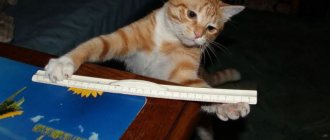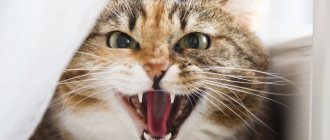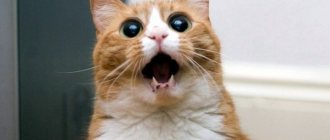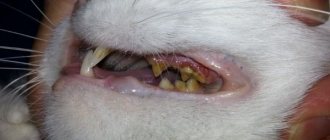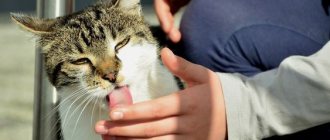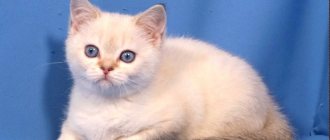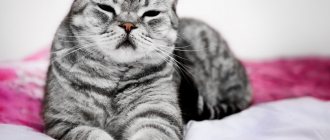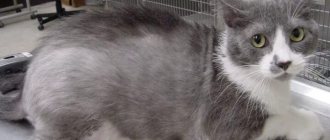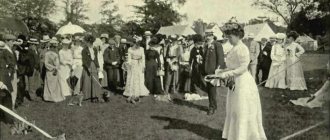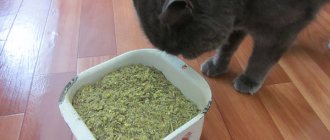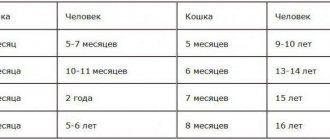How coat color is formed
As surprising as it may sound, the fur color of domestic cats is formed from only two primary colors: red and black. All other colors, except white, are just a combination of them. Moreover, the same gene is responsible for both black and red color in cats, existing in two alleles (forms):
- “O” - red (dominant allele);
- “o” - black (or rather, not red, recessive).
The color gene is located only on the X chromosome. In cats, ordinary cells contain, as is known, two of them. In cats, the set of chromosomes looks like this - XY. That is, in one of them (Y) the “O” (or “o”) gene is missing.
Accordingly, the genetic code of a female individual may look like this:
- “OO” - red coat color;
- "Oo" - tortoiseshell;
- "oo" - black (not red).
In this case, cat fur can only be:
- "OY" - red;
- "oy" - black.
Cat with short ears: Scottish breed
The most common representatives of short ears in the cat world are cats with curved miniature ears.
This breed is:
- Scottish Fold with short hair.
- Scottish fold cat with long hair.
These beauties are very similar. They differ in the type of coat. So, if you decide to get a kitten of one of these breeds, you should make your choice in advance.
It is worth noting that both Scottish Straights (with short hair) and Highland Folds (with long hair) require grooming.
The difference here is in the choice of a furminator - a comb that carefully removes excess undercoat, as well as in the length of its teeth.
By character, representatives of these breeds are very similar: they can be affectionate and gentle, friendly to children and other animals, or show leadership qualities and consider themselves masters of the house.
You should remember this when getting a kitten.
Click on the picture to enlarge it
How to select manufacturers
Parents can thus have four color combinations to produce red kittens:
- both parents are red;
- red cat - tortoiseshell cat;
- black cat - a red cat;
- black cat is a tortoiseshell cat.
By crossing a red cat with a black cat, you can only get black and tortoiseshell kittens. In this case, genes can only be folded in the following way: Oo, oU.
For red cats and male cats, all kittens will thus be red (OO+OU). There is simply nowhere for black to come from here. In this case, only shades of red are possible - red or cream (dilute red).
A black cat and a red cat will give birth to red boys and tortoiseshell girls. This is explained by the fact that the combinations of genes in this case can only be the following: OU and OO.
A black cat and a tortoiseshell cat can give birth to both black and red boys. Girls will be black or tortoiseshell. The possible combinations of genes in this case are: OU, OO, OU, OO.
A red cat and a tortoiseshell cat will also give birth to both red and black boys. In this case, the girls will be motley or red. Colors in this case are determined by combinations of genes: Oo, OU, oU, OO.
As you may have noticed, red boys can be born in any of four possible combinations of parental colors. That is why there are much more ginger cats than pure red cats.
Shades
The coat of cats can be either deep red, almost red (red Cat), or cream. A completely independent gene D, the “lightening” gene, is responsible for the brightness of the fur color of such domestic animals. In the dominant version D it gives a bright red color, in the recessive D it gives a “diluted” cream color. In the first case, the code for cats will look like D-OO, for cats - D-OY, in the second, respectively - dd-OO and dd-OY. Both cream and red pets certainly look very beautiful. Kittens of both these colors are very popular among animal lovers.
How to get bright red
Black fur in cats, like red, can have different intensities. Gene D can, of course, lighten such wool as well. If it is recessive, the black color will transform into gray, or, as breeders call it, blue.
This color, along with red, can, of course, be present in the color of tortoiseshell cats. Blue-cream girls, as well as black-and-red ones, can, of course, produce red kittens. Moreover, many breeders give preference to such females when breeding. The fact is that such cats, as has been noted, produce offspring with a brighter red color than pure red or cream ones.
Character
Abyssinians are incredibly curious. They need to look, taste and smell everything. The owner should be prepared for the fact that this cat will always suddenly appear nearby. But she is not interested in the role of an outside observer. She will actively participate in everything, sticking her paws and nose in, pushing away the owner himself. Sometimes such excessive activity can be annoying, but it is impossible to re-educate an Abyssinian.
This is perhaps the most energetic cat breed in existence. They are always on the move - either playing, or “helping” the owner, or inspecting their territory. They easily find something to do, instantly, like children, switching from one thing to another.
Abyssinians are very independent. They will never allow themselves to be picked up or placed on their laps if they don’t want to. But if they want affection, then they will show all their persistence in order to attract the attention of the owner. Considering that these cats are incredibly talkative, you should be prepared for the most active demands.
White
Of course, pure red cats and cats look absolutely gorgeous. However, red animals with white spots also look very good. This coloration is allowed by the standards of many breeds. Where does the white color come from on animal fur? After all, only one gene, red/black, is responsible for color in cats.
Animal fur gets its color from the pigment contained in the hairs. Phaumelanin gives the red tint to cat fur, and eumelanin gives the black tint. The white color of the coat of such pets is formed due to the presence of hairs that are completely devoid of pigment.
A special gene S is responsible for the presence of such spots in the color of cats and cats, including red ones. In animals, it can be present on the chromosomes as SS, Ss or ss. Depending on this, the pet will be almost completely white, with white spots, or completely red (black, tortoiseshell).
History of the breed
The oldest natural breed of cats has survived to this day in an almost pristine world. The description of Khao-mani is found in the ancient Thai manuscripts “The Book of Poems about Cats”. Then they had a name that can be translated from Thai as “all white.” The uniqueness of the animals, which originated in Siam, is in the purest snow-white color and bright blue, emerald, amber or heterochromic eyes.
Another name for these animals, which came from Thailand, is “diamond eye” or “diamond pearl”.
For a long time, these cats were kept only by royalty or wealthy nobles. Chulalongkorn V had eight snow-white pets, all of his descendants developed and steadily increased the number of royal favorites.
For many years, exporting the “property of Thailand” outside the country was prohibited under penalty of death.
Such isolation, on the one hand, preserved this breed in its natural form, on the other, made it very rare and expensive, and did not allow it to spread throughout the world.
The first representatives of Kao-mani came to the United States of America only in 1999; in 2001, a detailed description and breed standard appeared.
This ancient variety received official registration only in 2009 and only in the American international system TICA as an experimental one.
Location of spots
White areas on the fur of red cats can be found in different places. Moreover, such spots can have very different shapes. Different modifier genes are responsible for the location and appearance of white areas on cats' fur. Unfortunately, there is currently no clear information about which of them and how they affect stains. This is why it is usually very difficult for breeders to work with colors such as bicolor, harlequin, and van.
In ginger cats and cats, due to the fact that the genetics of these animals in terms of white spots has not been studied very well, it is not easy, for example, to get perfectly even “socks” or “mask”. Even two parents who are superbly colored in this regard may give birth to kittens with tight “stockings” or, for example, with a completely white head.
Description
The Abyssinian cat has a medium-length body with strong, muscular limbs. The head is round in shape; in adult, well-fed animals, the cheeks can even be distinguished. The eyes are regular almond-shaped, surrounded by light fur, but with dark lines along the contour.
The Abyssinian's coat is very soft to the touch and lies tightly to the body. The color is very specific - each hair has at least 4 dark zones. Short hairs have at least 2-3 different ticking stripes - alternating background areas, but when evenly distributed throughout the body, it does not form any pattern. At the same time, the line of the spine, the soles of the hind legs and the tip of the tail are colored more intensely.
Tiger stripes
Solid red cats and cats are quite rare. Almost always, on the fur of such animals, among other things, there are so-called tiger stripes. The T gene is responsible for their formation. The appearance of red cats can also be influenced by:
- Tb gene - marbled;
- Ta gene - iridescent agouti without visible stripes.
The Abyssinian color is considered dominant in relation to Tb, and Tb itself is considered dominant to Ta.
Shaded colors
Red Cat or Dilute red are the main red colors of cats. But this group of colors also includes “shaded” red fur. In such cats, the upper part of each hair is colored, and the lower part is white. Animals with such fur also look very beautiful, as they look “golden” or soft cream. Such cats usually look somewhat lighter than pure red ones.
Kittens with this color first grow pure red hairs. But at a certain age, the animal’s “slower” gene, Inhibitor I, comes into play. As a result, the production of the pigment responsible for the color of the coat either stops completely or slows down significantly.
Selkirk rex
Outwardly, such a cat looks like a curly bear cub or a small sheep. Animals of this breed can be either long-haired or short-haired. Thoroughbred ancestors, among whom were Persians, endowed their descendants not only with taciturnity, but also with an affectionate playful character. These animals are attached to their owner, get along well with children, and love to be in company. Such pets are able to sense the mood and state of a person: they come to console him, lie down on a sore spot. In size, they belong to large and medium-sized cats, weighing up to 6–8 kg. Selkirks live for about 17 years. The peculiarities of caring for these animals are associated with their thick fur, which must be combed at least once a day to avoid tangles. These cats shed heavily, and people with allergies should not have them.
